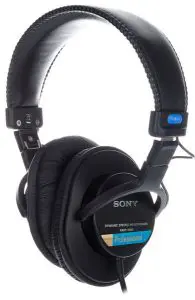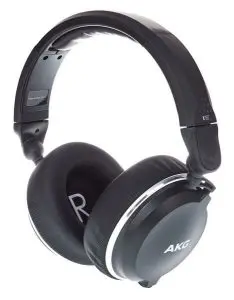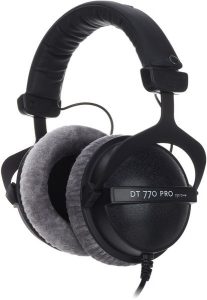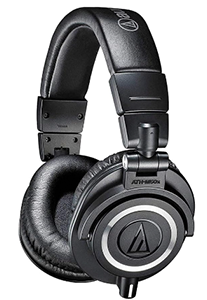Headphones are more than just a piece of equipment for online radio broadcasters; they are a critical tool. But where to start when it comes to choosing the best headphones for radio broadcasting? We’ve put together the essentials to help you understand what to look out for, as well a our selection of favourite headphones.
1/ Why are headphones important?
2/ How choose the right headphones?
3/ Our selection of headphones for radio broadcasting
Why are headphones important?
In the world of online radio broadcasting, having the right equipment is crucial to delivering high-quality content. One of the most essential pieces of gear for any broadcaster is a good pair of headphones. Here’s why:
1. Audio Quality Control
Headphones provide broadcasters with an accurate representation of what their audience will hear. Unlike speakers, which can distort sound due to room acoustics, headphones deliver a direct and precise audio feed. This allows broadcasters to monitor their voice, music, and other audio elements in real-time, ensuring that the final output is crisp, clear, and free of unwanted noise or distortion.
2. Real-Time Monitoring
Live broadcasting comes with its own set of challenges, including managing various audio sources simultaneously. With headphones, broadcasters can monitor multiple audio feeds, such as background music, callers, and co-hosts, without any delay. This real-time monitoring capability is crucial for making on-the-fly adjustments and maintaining a seamless broadcast experience.
3. Noise Isolation
A good pair of headphones with noise-cancelling features can significantly improve focus and concentration. By isolating external noise, broadcasters can immerse themselves in their audio environment, free from distractions. This is especially important in busy or noisy environments where maintaining audio clarity is essential.
4. Feedback Prevention
One of the most common issues in audio broadcasting is feedback, which occurs when the microphone picks up sound from speakers and re-amplifies it. This can create a disruptive and unpleasant loop of sound. Headphones prevent this issue by keeping the audio feed contained, ensuring that what’s picked up by the microphone is only the broadcaster’s voice or intended audio sources.
5. Professionalism and Listener Experience
Using headphones helps broadcasters present a more professional and polished broadcast. When broadcasters can hear exactly what their audience hears, they are better equipped to deliver a high-quality listening experience. This attention to detail can set an online radio show apart from the competition and build a loyal listener base.
6. Communication with Guests and Co-Hosts
For shows that involve multiple hosts or guests, headphones are vital for clear and effective communication. They allow broadcasters to hear each other without interference, making for smoother conversations and better coordination. This is particularly important for remote interviews and collaborations, where clear audio is key to maintaining a natural flow of dialogue.
How to choose the right headphones?
With the vast number of options available, choosing the right pair of headphones can feel overwhelming. Here are some key factors to consider when selecting headphones for radio broadcasting:
1. Sound Quality
The most important aspect of any headphones is their sound quality. Look for headphones that offer a flat and neutral sound profile. This means that they reproduce audio accurately without boosting or cutting any frequencies. Studio monitors are often recommended for broadcasters because they provide an honest representation of your audio, allowing you to make precise adjustments.
2. Comfort and Fit
Broadcasting sessions can be long, so comfort is paramount. Choose headphones with padded ear cups and an adjustable headband to ensure a snug fit without causing discomfort. Over-ear headphones are generally more comfortable for extended use compared to on-ear or in-ear models. Additionally, lightweight headphones can reduce fatigue during long broadcasting or recording sessions.
3. Closed-Back vs. Open-Back
Closed-Back Headphones are ideal for broadcasting because they provide good isolation from external noise and prevent sound leakage. This ensures that your microphone doesn’t pick up the sound coming from your headphones, reducing the risk of feedback.
Open-Back Headphones offer a more natural and spacious sound, however they are less effective at isolating noise and can leak sound. These are better suited for mixing and mastering rather than live broadcasting.
4. Noise Isolation and Cancellation
Noise isolation is crucial for preventing external sounds from interfering with your monitoring. Headphones with good passive noise isolation are designed to physically block out ambient noise. Active noise-cancelling headphones go a step further by using electronic processing to cancel out background noise. This feature can be particularly useful if you are broadcasting in a noisy environment.
5. Durability and Build Quality
Invest in headphones that are built to last, especially if you plan on using them frequently. Look for models with robust construction, high-quality materials, and replaceable parts like ear pads and cables. Durability is important to ensure that your headphones can withstand the rigors of daily use without degrading in performance.
6. Connectivity Options
Depending on your setup, you may need headphones with different connectivity options:
- Wired Headphones: These are typically preferred for broadcasting due to their reliability and consistent audio quality.
- Wireless Headphones: While they offer more freedom of movement, they can introduce latency and potential interference.
It’s incredibly important to test your equipment before you buy it (if you can)! This way, you’ll be able to get a more precise idea regarding the potential of your future acquisition.
Our selection of headphones for radio broadcasting
Sony – MDR 7506: $89


Further Specifications
– Detailed Highs and Clear Mids: These headphones offer clear and detailed high frequencies along with well-defined mid frequencies. This ensures that voices are reproduced clearly, which is crucial for radio broadcasting where vocal clarity is paramount.
– Padded Ear Cups and Headband: The headphones feature padded ear cups and a padded headband, providing additional comfort. The ear pads are designed to create a good seal around the ears, enhancing both comfort and noise isolation. The are also relatively lightweight, making them comfortable to wear for extended periods.
– Closed-Back Design: The closed-back design of these headphones provides effective passive noise isolation. This helps in blocking out external noise and preventing sound leakage, ensuring that what you hear is only the broadcast audio.
– Wired Connection: The MDR-7506 headphones come with a coiled, non-detachable cable that ends in a gold-plated 3.5mm plug, with a screw-on 1/4-inch adapter included. The wired connection is preferred for broadcasting due to its reliability and consistent audio quality.
– Impedance and Sensitivity: With an impedance of 63 ohms and high sensitivity, the MDR-7506 headphones are compatible with a wide range of audio equipment, from professional studio gear to portable devices.
– Frequency Response: They have a wide frequency response range of 10 Hz to 20 kHz, allowing for the reproduction of a broad spectrum of sounds, from deep bass to high treble.
AKG – K182: $100


Further Specifications
– Detailed Mids and Highs: These headphones provide clear and detailed mids and highs, ensuring that vocals and dialogue are reproduced clearly. This is crucial for radio broadcasting, where vocal clarity is essential.
– Extended Bass Response: While maintaining a balanced sound, the K182 headphones also offer a solid bass response, which can be beneficial for music segments and overall audio richness.
– Over-Ear Design: The over-ear design of the K182 headphones ensures that they cover the ears completely, providing a comfortable fit for extended use. This design also helps with passive noise isolation.
– Closed-Back Design: The closed-back design of the K182 headphones provides effective passive noise isolation, helping to block out ambient noise and preventing sound leakage. This ensures a focused listening experience, crucial for monitoring audio during broadcasts.
– Detachable Cable: The K182 headphones come with a detachable cable, which adds to their durability and ease of use. The cable is replaceable, reducing the need to replace the entire headphone if the cable gets damaged.
– Impedance and Sensitivity: With an impedance of around 32 ohms and high sensitivity, the K182 headphones are compatible with a wide range of audio devices, from professional studio equipment to portable devices.
– Frequency Response: They offer a frequency response range of approximately 10 Hz to 28 kHz, providing a broad spectrum of sound reproduction from deep bass to high treble.
Sennheiser – HD-280 Pro: $129


Further Specifications
– Wide Frequency Response: With a frequency response of 8 Hz to 25 kHz, these headphones cover a broad spectrum, allowing for detailed monitoring of both low and high frequencies.
– Clear Midrange and Highs: The headphones deliver clear and detailed midrange and high frequencies, which is crucial for vocal clarity in radio broadcasting.
– Padded Ear Cups and Headband: The HD-280 Pro features generously padded ear cups and an adjustable, padded headband, ensuring comfort during long broadcasting sessions.
– Closed-Back Design: The closed-back design provides excellent passive noise isolation, which is crucial for radio broadcasting environments to prevent external noise from interfering with audio monitoring.
– High Attenuation: The headphones offer up to 32 dB of ambient noise attenuation, ensuring a focused and undisturbed listening experience.
– Impedance and Sensitivity: With an impedance of 64 ohms and high sensitivity, the HD-280 Pro headphones are versatile and can be used with a variety of audio equipment, from professional studio gear to portable devices.
– Replaceable Parts: The ear pads and headband padding are replaceable, which extends the life of the headphones and ensures they remain comfortable and functional over time.
Beyerdynamic – DT770 Pro: $169


Further Specifications
– Wide Frequency Response: With a frequency response of 5 Hz to 35 kHz, these headphones cover a broad range, allowing for the detailed reproduction of both low and high frequencies.
– Clear Midrange and Highs: The DT770 Pro headphones offer clear and detailed midrange and high frequencies, ensuring that vocals and other critical audio elements are well-represented.
– Excellent Bass Response: The headphones deliver a solid and precise bass response without overpowering the mids and highs, which is beneficial for a full and rich audio experience.
– Closed-Back Design: The closed-back design provides excellent passive noise isolation, which is essential for radio broadcasting to prevent external noise from interfering with audio monitoring.
– Effective Attenuation: The design helps to significantly reduce ambient noise, allowing broadcasters to focus on their audio work without distractions.
– Replaceable Parts: Key components like the ear pads and headband padding are replaceable, which extends the lifespan of the headphones and maintains comfort over time.
– Different Impedance Options: The DT770 Pro is available in multiple impedance versions (32 ohms, 80 ohms, and 250 ohms), allowing users to choose the model that best fits their equipment and usage scenario.
– Versatility: The DT770 Pro headphones are versatile and can be used with a variety of audio equipment, from professional studio gear to portable devices, depending on the impedance chosen.
Audio-Technica ATH-M50X: $155


Further Specifications
– Wide Frequency Response: With a frequency response of 5 Hz to 35 kHz, these headphones cover a broad range, allowing for the detailed reproduction of both low and high frequencies.
– Clear Midrange and Highs: The DT770 Pro headphones offer clear and detailed midrange and high frequencies, ensuring that vocals and other critical audio elements are well-represented.
– Excellent Bass Response: The headphones deliver a solid and precise bass response without overpowering the mids and highs, which is beneficial for a full and rich audio experience.
– Closed-Back Design: The closed-back design provides excellent passive noise isolation, which is essential for radio broadcasting to prevent external noise from interfering with audio monitoring.
– Effective Attenuation: The design helps to significantly reduce ambient noise, allowing broadcasters to focus on their audio work without distractions.
– Replaceable Parts: Key components like the ear pads and headband padding are replaceable, which extends the lifespan of the headphones and maintains comfort over time.
– Different Impedance Options: The DT770 Pro is available in multiple impedance versions (32 ohms, 80 ohms, and 250 ohms), allowing users to choose the model that best fits their equipment and usage scenario.
– Versatility: The DT770 Pro headphones are versatile and can be used with a variety of audio equipment, from professional studio gear to portable devices, depending on the impedance chosen.
Note: Generally, headphones are delivered with a 6,35 mm adapter which you can then connect to your mixing desk.
You’re now ready to broadcast under the best conditions with your new headphones! For a reasonable price, you can obtain headphones that are comfortable, neutral, and closed to give you the impression that you’re alone with your listeners!
